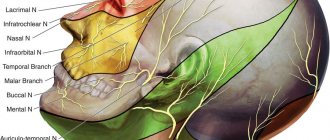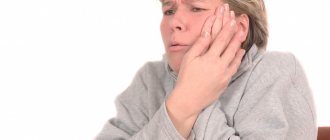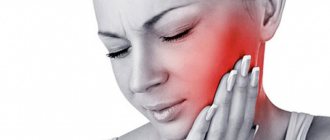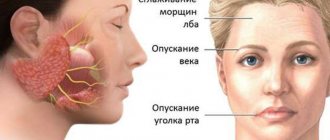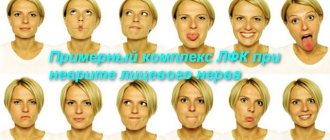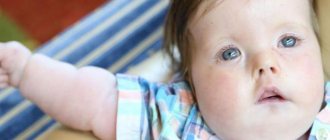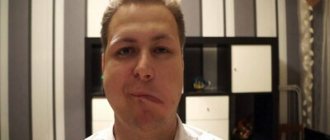| Advisory services | ||
| Initial consultation with a neurologist (60 min) | 1300 rub. | Sign up |
| Repeated consultation with a neurologist (30 min) | 700 rub. | Sign up |
My friend, a young and pretty girl, woke up one morning and looked at herself in the mirror and was horrified.
Half of her beautiful face “slipped” down. Turning to the doctor, she heard an incomprehensible and scary at first glance diagnosis of “Neuropathy of the facial nerve.” My friend's story ended with a happy ending, she made a full recovery. This happened for a number of reasons, but most importantly, she was lucky enough to fall into the sensitive hands of a qualified and experienced doctor, who improved her health and restored her self-confidence. So what happened and for what reason could this happen?
The facial nerve is responsible for the work of facial muscles, and also regulates the activity of the lacrimal gland and provides taste sensitivity to the front of the tongue. Due to hypothermia or infection with acute respiratory viral infections, neuropathy of the facial nerve can develop, a disease characterized by impaired motor activity of the facial muscles. This condition is called paresis.
Causes
There are many reasons, it is often impossible to clearly differentiate a specific factor, which is when we talk about idiopathic Bell's palsy. Often the cause is an infectious-allergic lesion. It develops in the second or third week after an acute viral infection. Hypothermia may also be an additional cause. Neuritis often develops as a result of traumatic lesions, sometimes during plastic surgery, surgery on the salivary glands, and surgery for sinusitis. In this case there is a clear connection with trauma; Treatment usually does not give good results.
Symptoms
The symptoms are quite numerous. Depending on the degree of damage, localization of the main lesion, phase of the disease:
- Weakness of the facial and chewing muscles on one side, manifested in facial asymmetry and sagging cheeks.
- Leakage of food from the mouth.
- Lagophthalmos is the inability to completely close the eye, leaving a small strip of white.
- Impaired sensitivity of the tongue.
- Watery eyes or, conversely, dry eyes.
- Numbness of the cheek, soft palate and tongue.
- Impaired facial skin sensitivity.
- Pain in the parotid region is especially common with infectious-allergic lesions.
Long-term untreated neuritis can lead to persistent pathological manifestations. The clinic in this case will be as follows:
- Persistent paresis of the facial muscles.
- Facial sensitivity disorders.
- Pathological twitching - synkinesis - in the cheek, eyebrows, etc. Often accompanied by severe unpleasant or even painful sensations.
Methods for conducting EMG of facial muscles
Doctors recommend that patients, on the eve of EMG of the facial muscles, in consultation with the treating neurologist, stop taking medications that affect the nervous system and do not drink chocolate, coffee, tea, cola and other tonic drinks. You should refrain from smoking on the day of the procedure. Before applying electrodes to the skin of the face or inserting them into muscles, the patient is asked to remove metal jewelry from the face and ears.
Stimulation electromyography of the masticatory and facial muscles is performed using electrodes that are applied to certain points on the facial skin. Then an electrical discharge of minimal strength is applied. Using a computer program, the speed and volume of excitation passing through the nervous tissue is recorded. Based on these data, the neurophysiologist makes a conclusion about the state of the nervous tissue and the level of its damage.
When performing needle EMG of the facial muscles, the doctor inserts a special conductor needle into the facial muscle. Through it, muscle tissue is stimulated with electric current, followed by registration of the response and processing by a computer program. When performing needle EMG of the facial and trigeminal nerve in the Yusupov Hospital, only special high-quality disposable foreign-made needle-guides are used. The combined use of needle and stimulation electromyography techniques of facial muscles and nerves makes it possible to assess their condition with maximum accuracy, timely establish a final diagnosis and prescribe adequate therapy.
Diagnostics
Diagnosis is usually not difficult for neurologists. The diagnosis is established based on medical history and neurological manifestations. In case of an old process, it makes sense to conduct ENMG of the facial nerve, which reveals a decrease in the excitability of nerve fibers and a decrease in the speed of impulse conduction.
Treatment
Treatment of neuritis of the facial nerve, especially with acutely developed manifestations, should begin immediately. Therapy includes drug treatment, physiotherapy techniques, exercise therapy, taping therapy (adhesive plaster traction).
- Drug treatment necessarily includes the prescription of neuroprotective drugs (primarily B vitamins), vascular therapy (Trental as the drug of choice), antioxidant treatment (Mexidol, vitamin E can be used), and hormonal treatment. Prednisolone for neuritis of the facial nerve is prescribed in the case of an infectious-allergic nature of the lesion and only in case of early treatment by the patient (on the first to fourth day after the onset of the disease). The hormone is prescribed in a decreasing pattern. Typically, on the first day, 50-70 mg is prescribed (10-14 tablets, in two or three doses), the dose is accumulated for the first three days, then there is a gradual (5 mg per day) reduction in the dosage until it is completely discontinued.
- Various techniques are used in physiotherapy. Electrophoresis with proserine and magnetic fields are often used. Prescription of procedures occurs only after consultation with a physiotherapist, identification of contraindications and the best method of treatment. In the recovery phase, as well as in case of long-term consequences, massage can be prescribed. Facial massage is done very carefully, using an activating technique on the affected side. Massage is an excellent procedure for preventing the development of synkinesis.
- The exercise therapy complex consists of exercises that allow for early muscle activation. When performing exercises, the healthy side is usually supported by the hand. This is necessary so that further redistribution of tone in favor of healthy muscles is not aggravated.
- Taping therapy involves applying adhesive tape to the weak muscles of the affected area. Sometimes it is during taping therapy that it is advisable to engage in physical therapy exercises. Depending on the number of muscles affected, a different number of adhesive tapes are applied. The time for one procedure is 1-2 hours.
Gymnastics and massage for neuritis of the facial nerve
During therapeutic gymnastics procedures, it is recommended to perform special exercises in front of a mirror (sitting and standing). Before each exercise, you should relax the muscles, especially on the healthy side. You should not use exercises only for the painful side; you must simultaneously carry out exercises on both the diseased and healthy half of the face, achieving symmetrical movements.
For this purpose, it is necessary to limit the range of movements on the healthy side, and also hold the healthy side with your hand. On the affected side, exercises are performed with the hand passively, and when minimal active movements occur, with the help of the hand. It is more advisable to apply therapeutic gymnastics procedures 2 times a day.
Exercises for facial muscles must be performed between general strengthening exercises, since paretic facial muscles get tired quickly. Breathing exercises are of great importance, especially if there is a speech disorder.
If it is difficult to reproduce the specified movements, then to increase the conductivity of the facial nerve of the affected side, galvanization of the nerve exit site is used with a cathode. During the passage of current, it is easier to make facial movements on the affected side. Therapeutic gymnastics can be used against the background of thermal procedures (after solux, diathermy).
PREPARATORY MASSAGE
1. With cleanly washed hands, the patient sits in front of the mirror and begins massaging the forehead. Movements should be light, superficial, flat, not causing redness of the forehead skin. 2. Then massage the area of the eye sockets, while looking down, closing the eyes (on the sore side, close the eye with the palmar surface of 2-3 fingers). Start the massage from the inner corner of the eye to the outer and then to the parotid area. 3. Next, we massage the nasal area: we start from the wings of the nose and massage to the parotid area. 4. Massage of the perioral area: from the middle of the mouth to the corner of the jaw. 5. Chin massage (also starts from the middle of the chin to the corner of the jaw). 6. Massage the neck area (along the front surface). 7. Then make head movements forward, backward, right, left. 8. For young and middle-aged people – circular movements of the head.
After the massage, we begin to perform exercises.
Perform all exercises from 5 to 10 times.
1. Wrinkle your forehead. 2. Closing the eyes. 3. Frowning the eyebrows. 4. Sucking in air through the nose. 5. Alternately closing the eyes (winking). 6. Movement of the nose, simulating a feeling of displeasure. 7. Baring teeth. 8. Smile from the corner of your mouth (smirk). 9. Pulling the cheeks into the oral cavity. 10. Puffing out the cheeks. 11. Movement of the lower jaw to the side. 12. Movement of the tongue in the oral cavity. 13. Air rinse your mouth. 14. Rinse your mouth with warm water. 15. Pulling the lips forward into a “tube”. 16. Whistle. 17. Pronunciation of consonants: B, P, M, X, C. 18. Pronunciation of vowels.
The entire set of exercises, including preparatory massage, is performed every 2-3 hours throughout the day.
EYE EXERCISES
1. Close your eyes tightly - 30 sec 2. Look squint - 30 sec 3. Stare your eyes - 30 sec 4. Make a normal look 5. Wink alternately with your left and right eyes, repeat 10 times 6. Extend your arm forward and, without taking your eyes off with your index finger, guide it to your nose, and then, touching your nose with your index finger, move your hand away (do it slowly), repeat 10 times 7. Frown your eyebrows - make a “bright look” 8. Move your eyeballs from right to left 9. Press with three fingers of each hand on the upper eyelid for 1-2 seconds, repeat 3-4 times 10. Using your index fingers, press the skin in the area of the superciliary arches and slowly close your eyes. The fingers hold the skin of the brow ridges and provide resistance to the muscles that close the eyes. 11. Place the index, middle and ring fingers (over open eyes) and lower, close your eyes, creating resistance with your fingers, repeat 8-10 times 12. Close your eyes and slowly rotate them in the sequence: left, up, right, down, then – in the opposite direction, repeat 5-10 times in each direction.
LIP EXERCISE
1. Exercise “Lips-Teeth” (we pronounce the sounds U-I) - lips in a tube and in a smile. 2. Turn the elongated lips left and right like a tube. 3. Raise and lower your upper lip. 4. Scratch your upper lip against your upper teeth. 5. Bare your teeth, pulling your lips on the right and left sides. 6. Exercise “Coachman”: say prrrrr 7. Whistle. 8. Imitation of spitting.
LANGUAGE EXERCISES
1. Lift the tongue up behind the teeth, lower it behind the lower teeth. 2. Raise your tongue to your upper lip and lower it onto your lower lip. 3. Place your tongue on each cheek with your mouth open. 4. Exercise “Painter” - stroke the hard palate with your tongue back and forth. 5. Lick your lips with your tongue. First clockwise, then counterclockwise. 6. Stick your tongue between your teeth and blow hard. 7. Exercise “False candy”: rest your tongue on each cheek. 8. Exercise “Delicious jam”: lick honey or jam from your upper lip with your tongue. 9. Imitation of a cat lapping milk. 10. Exercise “The turkey is angry”: bl, bl, bl (quick movements of the tongue along the upper lip). 11. Exercises “Woodpecker”: pronounce the sounds t-t-t-t; td-td-td-td; tdd-tdd-tdd-tdd; tdddd-tdddd-tdddd-tdddd; tdddddddd, tddddda, tdddddo, tdddddu, tdddddy. 12. Roll radishes and cream in your mouth with your tongue. 13. From the inside, work out the inner walls of the cheeks with a brush cleared of bristles.
